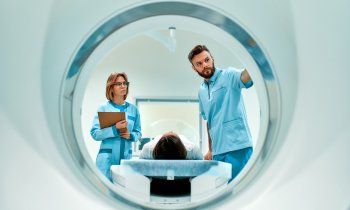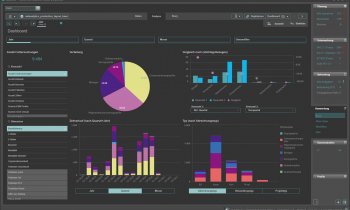
Sponsored • Keeping up with all developments
Heading into the future with a new generation of PACS
The Vienna General Hospital in Vienna, Austria, already launched its first image data management system (PACS) in 2001 from Agfa HealthCare, today Dedalus HealthCare. The migration to IMPAX EE occurred in 2014. At the beginning of 2022, the Vienna General Hospital took the next step and, with DeepUnity, introduced the next generation of PACS, which is used in clinics around the world today. ´The partnership with Dedalus HealthCare was always very appreciative and constructive, innovation-driven, and user-oriented’, says Prof. Dr Christian Herold, Head of the University Clinic for Radiology and Nuclear Medicine, praising the partner.
What requirements do radiologists place on a modern image data management system today? Assoc.-Prof. Priv.-Doz. Dr Helmut Prosch, Department Head Deputy of the Clinical Department for General Radiology and Infant Radiology: ’It needs to make our basic activities easier, which also includes visits by doctors in training. In addition, it helps us in multidisciplinary meetings. We can answer all questions rapidly there. The system is extremely responsive. In PACS, I can display anything I want live at any level.’ Around 530 interdisciplinary discussions take place every month. Ten to fifteen patients are discussed in every meeting. So radiologists deal with 5,000 to 6,000 cases every month in the case meetings alone.
AI as a game changer

For Prosch, IT has a key role in overcoming these challenges. The expert names the use of artificial intelligence (AI) in diagnostics as an example. ’The automatic detection of pathological changes to organs and their quantification, for example, saves us a lot of time and gives patients and referring physicians important additional information’, says the department head deputy. Prof. Herold takes the same line, although he sees challenges associated with this: ’Yes, AI will be a very key aspect for us. But there are a great many developers, start-ups and also academic institutions in this segment who are developing their own algorithms for different applications. Therefore, it is fully impossible to purchase and/or install all these algorithms. Instead, the trend is moving towards migrating them to one platform or to existing systems – such as those in medical technology – or integrating PACS. This integration seems to work very well at Dedalus HealthCare.’
The software from contextflow, a spin-off of the Vienna General Hospital, is used in Vienna for example. ’The algorithm is integrated in our PACS so that I can load the information that has been prepared previously on a separate server into the report workflow with one mouse click and incorporate it into my assessment. The seamless integration, together with quick loading times, is greatly contributing to the high level of acceptance. For me, this duo is a successful example of an AI application in radiology’, praises Dr Sebastian Röhrich, a doctor in training at the University Clinic for Radiology and Nuclear Medicine.
New technologies for teaching
Training will be simplified further for him and his colleagues thanks to a modern teaching image archive in PACS. ’This is actually a tool that we are building for the future. The learning system will help us to easily prepare didactically valuable cases. During the reporting process, we use drag and drop to drag these images into a special teaching folder. They are automatically anonymised, catalogued and then provided with the corresponding text there’, says Prosch as he describes the process. In any case, it is important that the teaching archive runs in the usual platform, i.e. the PACS environment. Students could use online access to work on cases themselves no matter where they are.
13.12.2023










